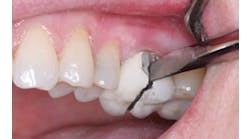By Amy Morgan, CEO Pride Institute
Have you ever been excited about implementing a new skill, service, or product after a motivating continuing-education experience, only to have your ideas fade into a distant memory three weeks later? There are real reasons why integration of new information can be a daunting prospect at best and impossible at worst.
This article approaches the task of integrating new skills into your practice from the viewpoint of what not to do. This is an easy article to write, because not accomplishing something seems to be much easier than accomplishing it. For example, not getting a job involves not selecting a career, not educating oneself, and not looking for work. After sliding into this mindset of inaction, we can complain that no one ever gives us a break and therefore have a ready-made excuse for not instituting positive changes in our lives.
Of course, dentists do not fundamentally have this mindset of passivity at all. Dentists can be among the most successful people in America because they expend great effort in getting a rigorous education, establishing a rewarding practice, delivering ideal care, and achieving their personal and professional goals. Successful dentists are ambitious, hard-working, and focused. However, when it comes to integrating innovation and change into an existing practice, this "not accomplishing" cycle is very often the case.
Implementing ideas for new systems and behaviors in a practice always depends on the willingness, collaboration, and follow-through of the staff. Change is not something dentists can accomplish by themselves. A dentist may have felt extremely confident and effective when relying on his or her own skills to get through school and deliver ideal dentistry. However, when it comes to implementing change through training and motivating the staff, many dentists feel tremendously frustrated and unsuccessful.
If you have been in practice for more than a year, you have probably learned how to not accomplish the implementation of new ideas. Let's start with the top eight "not-to-dos":
1) not realizing the effort that is needed to truly implement and integrate information;
2) not gaining the hearts and minds of your staff for making the changes necessary to achieve your goal;
3) not engaging your staff at every stage of the learning and implementation;
4) not maintaining your own enthusiasm and resolve when you encounter snags, obstacles, and barriers;
5) not being flexible about the process and inflexible about the outcome you want to achieve;
6) not defining the specific steps and actions to accomplishing your goal for change;
7) not establishing a specific timeline for integration, with benchmarks to monitor pace and progress;
8) not acknowledging and celebrating progress along the way as well as your ultimate success.
When any of the eight "nots" are present, effective integration will fail to take place for the long term. Whether you want to implement something as complex as CEREC crowns, which involves a major overhaul of virtually every office system, or you want to implement something as simple as placing a lavender mist on the bibs of patients as a value-added service, here's an example of how not to accomplish your objective.
You attend a CE course and get a new customer-service idea. You want to mist patients' bibs with a lavender spray as a value-added service. You believe that this will be a way to bring your customer service to a new level, and it sounds easy. Welcome to Pride's "10 Steps to Getting the Least Out of Your CE Courses." You will notice that all eight "nots" are widely represented in these 10 steps.
1) Attend the CE course by yourself, or bring your staff without communicating any specific benefit or focus for the learning. Leaving the staff at home is a sure-fire way to guarantee their lack of understanding, interest, and enthusiasm for what you want to accomplish. If the speaker fired you up, why exclude the staff from having the same motivating experience and getting the big picture of the practice goals? Even if you bring the team, if you don't identify a personal benefit to learning the information, it will not stick. Explain what's in it for them. New technology makes their job easier, value-added services give them more to offer patients and make patients more appreciative of their efforts, and new clinical techniques keep them on the frontier of their profession and increase their value in the marketplace.
2) Don't tie the change you want to the vision of your practice. Not integrating the change to your practice vision can leave the staff with the impression that there is no compelling reason or benefit to making the change. When every new skill or action you take in the dental office advances the practice toward its vision and goals — and the staff can see that — they embrace the big picture and support the change. This makes the team feel goal-directed versus crisis-directed. If your vision is to surprise and delight patients with unexpected customer-service touches that show your thoughtfulness, then you can show how lavender-misted bibs personify and support this vision. This tie-in with your vision will give you the buy-in you need from your team.
3) When announcing the new information to your staff, don't discuss any questions or misgivings they may have or any suggestions of different ways to accomplish the same result. Telling your staff that you purchased 10 spray bottles of lavender solution and you want everyone to start using them immediately will ensure that your new product collects dust on the shelf. Without communication and direction from you, your staff will not understand the reason for the change in their routine and the mechanics of how to accomplish it. When staff members are not given a chance to respond to your idea, they feel left out. The process of motivating, training, and focusing your team must be a dialog, not a monologue. Their agreement and commitment are very important; your new idea, therefore, must first be sold to the staff before you can successfully implement it. Your team members need to understand how the change not only supports the practice vision, but how they can personally benefit from it as well. Any change — whether positive or a challenge — causes people to feel isolated, artificial, and focused on what they might lose. The staff must also have a forum to safely voice failures along the way without recriminations so that they can rise above change-resistance and succeed.
4) Don't guide the staff in working out the action steps and don't lead them in assigning responsibility for accomplishing them. Your new idea will fail if you do not lead the staff in defining the nitty-gritty of an implementation plan. Who will spray the bibs? When will the spraying be done — before the patient arrives, at the beginning of the day, when the patient is seated, or when the bib is placed on the person? Where will you store the spray bottle and will it be in easy reach? Will you violate any OSHA standards? What if some patients don't like the smell of lavender? What are the verbal skills to accompany the action? Will the bibs of all patients be misted or only the anxious ones? What will the timeline be for launching the new service? You needn't — and shouldn't — develop the steps yourself, but you can't expect the staff to work out all of the details by themselves either. Direction, coaching, and collaboration with the staff are the keys. Without jointly identifying with the staff all of the details, requirements, steps, timelines, and responsibilities involved in implementing the change, be assured it will not take place.
5) Go on a crusade for lavender-misted bibs on the day you return from your CE course, then never mention the matter again. Acquire a reputation with your staff for not following-through, and rest assured that the fever gripping you after a CE course will soon subside. The staff will keep a vigil and wait it out. Not being consistent and steadfast in the changes you want to make will ensure the defeat of any ideas. Staff members need to know that what you ask of them today will be important to you tomorrow as well. If not, you will fail to gain credibility, which creates a cynical team that does not trust its leader to make it all the way to the finish line. If the priorities keep changing, then the staff will not know what is really necessary to do regularly and what can be set aside, especially when they become busy. All goals, changes, and tasks will be judged in this same manner and therefore innovation will stop.
6) Have no forum, i.e., no staff meetings or feedback opportunities, to discuss the changes. Like all of us, staff members are much more receptive to changes when they're consulted, asked for their views, given a chance to raise concerns, etc. Collaboration, discussion, strategizing, action planning, discussing obstacles that arise, resolving them, and measuring results occur at staff meetings and one-on-one feedback sessions. Trying to implement things on the run while patients are being seen will leave you with the impression that no one is listening.
7) Don't inspect what you expect. Every few months, notice that the lavender spray isn't being used and complain to the staff. This will result in their embarking on a misting frenzy for a few days, then stopping again when your attention shifts to other things. Follow-through needs to be consistent. This includes immediately catching your staff implementing the lavender spray, acknowledging their actions, and projecting the positive consequences for the future. Without a way to monitor and report results with regularity, everyone will naturally have a tendency to revert back to old, familiar habits. If you are not helping your staff to acquire new habits by inspecting what you're expecting, your fresh new idea will soon become stale.
8) Give up at the first sign of difficulty. Your assistant complains that the lavender mist got into the patient's eyes. Your hygienist reports that patients don't like being misted like plants. Your patient coordinator can't find room in the treatment rooms for the spray bottle. Wow, what a lousy idea you had! As the leader of your practice, you have to be the one whose enthusiasm and confidence is unwavering. I call it the "unkillability" factor that all leaders must have in order to succeed. Real or perceived obstacles must be addressed, not tiptoed around. Maybe you'll need to build a special shelf for the spray bottle in the treatment rooms to make it easy for the staff to do what you want them to do. You will have to address and at times modify the process, while staying unkillable on the ultimate outcome.
9) Don't praise the staff when they are doing it right. What gets acknowledged gets repeated. Praising and celebrating the staff's step-by-step progress in using the spray bottle encourages them to repeat the same behavior. Forgetting to praise, acknowledge, and thank the staff for making progress — or waiting until the entire process is completed to praise — guarantees that the staff will not continue using the spray bottles. They will think that you do not notice what they are doing or recognize their efforts. So why bother to incorporate an extra step into their routine when it goes unnoticed and unappreciated?
10) Complain that the staff is uncooperative and give up going to CE courses because they depress you! If you blame the staff for failures that may be caused by your lack of strong leadership, you'll get discouraged and lose confidence in your ability to implement change in your practice. If you want to know why your team acts the way they do, look in the mirror. The only person you can ultimately control is yourself. How you approach the change process and support your staff is the make-or-break point for successfully introducing innovations. Blaming the staff is an excellent way to prevent your practice from moving forward and to create a defensive team that won't risk change in the future.
I've given you Pride's "10 Steps to Getting the Least Out of Your CE Courses," which encompass all of the what-not-to-dos. Now are you ready to succeed instead? Success is a lot easier and certainly more enjoyable. By utilizing successful models that ensure change is implemented, you and your staff will gain a greater sense of accomplishment and confidence. Successful models will always involve collaborating with the staff and tying your idea to the practice vision.
Develop the staff and systems you need to implement new ideas. Learn from Pride's consultants and client-dentists who conduct lively, meaty, AGD-accredited seminars around the country. For dates and locations, seethe ad in this issue or call Pride Institute at (800) 925-2600.





